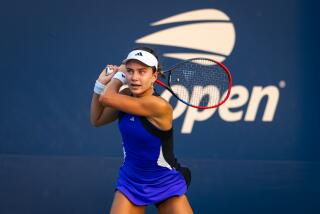Youths Ready to Serve to Their Teen Elders : Tennis: Finding a 16-year-old at the Girls’ 16s National Tennis Championships is hard to do.
- Share via
SAN DIEGO — It’s supposed to be the girls’ 16s, but it’s hard to find a player who actually is.
In fact, even before Thursday’s quarterfinal field of the Girls’ 16s National Tennis Championships had been cut in half, only one player had reached sweet 16. The rest were 14- and 15-year-olds.
How low do they go? One player, seventh-seeded Stephy Halsell of Cypress, Tex., who was upset in the round of 16, is a mere 12.
Playing up an age group, or two in Halsell’s case, has become as common a practice in girls’ tennis as playing the baseline.
Carol Watson, United States Tennis Assn. player development representative, said that the reasoning behind it is simple, although the process behind it isn’t always so.
“They’re trying to go up to that next level a bit sooner,” said Watson, who is here to keep tabs on a handful of players in the tournament at Morley Field this week. “A lot of factors play into it. They have to discuss it with their private coach, with their parents, and a lot of it depends on the section they’re in.”
Just because a player is having a good year and feels like trying her luck in a higher age group doesn’t mean it will happen automatically.
“The section gets heavily involved, and each one’s different,” Watson said. “The players have to work with the player development person within their section, to make sure it’s not too early.”
For several of Thursday’s winners, the timing is just fine.
Top-seeded Amanda Basica of Rolling Hills Estates, who turned 14 two months ago and is playing in 16s for the second year, advanced to the semifinals with a 6-1, 7-5 victory over Jennifer Hall of Oklahoma City, Okla. She will face unseeded Corina Morariu of Boca Raton, Fla., at 10:30 this morning. Morariu was a 3-6, 6-2, 6-1 winner over fourth-seeded Leslie Cook of Boynton Beach, Fla., in a matchup of another pair of 14 year-olds.
The other semifinal is also the older one. Spring Valley’s Vanessa Rooks, 16, had some lapses against St. Louis’ Laura Guignon, but eventually took the match, 6-4, 6-3. Rooks, seeded third, will face Christina Moros, 15, of Sarasota, Fla., at 9. Moros was a 6-0, 6-4 winner over Chula Vista’s Marisa Velasco, also 15.
But the players don’t seem to care where they’re playing, as long as they’re getting challenged. There’s nothing wrong with the competition in their division, they’ll tell you, it’s just that it’s so much better somewhere else.
“More competition,” Basica cited as the only reason to move up. “Everyone else moves up, so there’s no reason to stay.
Everyone else who is consistently winning that is. In 1990, the last time she played 14s, Basica got as high as fifth-ranked before she had outgrown her opponents and moved on.
The girls tend to dabble in different age groups more frequently than their male counterparts. Several of the top-ranked 16-year-olds are playing in 18s this week in San Jose, including Ann Miller and Mashona Washington, last year’s winner and runner-up.
“I think it’s good you can move around,” said Basica, who lost to Miller in the round of 16 last year. “But the boys stay. They’d get killed if they moved up.”
As would the majority of players who climbed an age group or two. But Watson said a players’ ability to play “up” is considered carefully before allowed.
“If a player does well in an age group, they tend to think they won’t be too much over their head if they move up,” she said. “You have to weigh the pros and cons. If they’re strong enough and mature enough, and you think they’re ready, you let them test it.”
More to Read
Go beyond the scoreboard
Get the latest on L.A.'s teams in the daily Sports Report newsletter.
You may occasionally receive promotional content from the Los Angeles Times.










